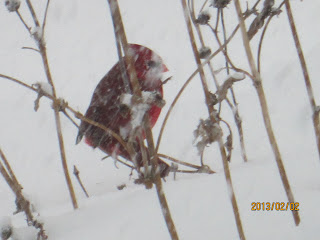CountyKate comments on the winter in Ontario
It is said that we have forty words for snow.
Actually it is the Inuit people that have forty words for snow. I suspect we all have our own vocabulary of words for snow, many will be of Anglo=Saxon origin, others will be swear words!
I am reading today, mid-February, that England can expect another month of ;Arctic' weather: here in Ontario snow and ice may not let up until April. We have a generous layer on the ground, about 35 cms, the accumulation of two separate snowstorms, and though today's temperature is 'warm' at about plus 1 Celsius, it wom't ,eam am overnight melting, causing floods and overflowing rivers.
There are several different types of snowfalls, or storms. Our first, two weeks ago, was like fairytale snow, or a Christmas card portrayal.
Falling straight down to earth, with no hint of wind to direct its course, the fat, feathery flakes accumulated on every branch and twig. Every roof line was mimicked by the snow; every modern convenience - car, tractor or bus wore a conical hat and my birdfeeders looked like a forest of gnomes
The bird population battled on with our help as we scattered handfuls of seeds and peanuts, clearing off the bird tabl each time. The snow was so deep that small birds landed and promptly disappeared up to their heads. It continued for 12 hours and next day it ws a wonderland. Photographers were ecstatic at the opportunities - snow plough drivers less so.
Then a week later, another snowfall but this was windblown, icy little droplets coating hair and face.
Warm clothing required in this weather!
The final accumulation was another 25 cms; my husband and his brother spent two hours clearing the driveway and paths - we have a long drive and needed the access.
I used to drive a school bus and snowy weather was always a challenge.. Sometimes the school board would declare a 'Snow Day' - schools would be closed and buses did not run. I went out on my rural route once after a Snow Day taking the roads carefully, confident the council would have cleared the route I usually took, some of which involved farmers' access roads. In brilliant sunshine, I topped a rise and before me was another school nus, broadside across the road.
No way forward and I couldn't reverse back. My passengers, high school students, realised we could be there for a while so began calling parents on their mobiles to bring coffee, warmer clothing or even a lift home. They gradually dispersed as parents turned up until the relief bus appeared. As one the remaining kids exited the bus by the side passenger door, leaving me, a slightly bulky lady, to jump into the snow banks. Which I did, but my ankle turned over and I fell on hands and knees, Nothing for it but to crawl around the bus looking for leverage.
Next day, equally beautiful but the roads had icy ruts now, which my bus decided to follow. Cursing, struggling with the wheel, I stopped the bus, leaning over, with a good crunch as we came to rest in a ditch. The passenger door was blocked, so with the usual phone calls made the kids left en masse via the emergency door at the rear of the bus. At least four feet from the ground, I needed a friendly hand but none available, I jumped and slithered, landing on my bum. Stuck I contemplated grizzling, but the snow plough driver appeared and hauled me up.
Pioneers arriving on the County back in the early days of colonisation had their own priorities. If they arrived while it was still summer or spring, logs had to be cut at once to make a log cabin, probably not much bigger than our modern garden sheds.Moss would be stuffed into the chinks between the logs, a fire hearth built, and possibly there would have been no windows to begin with as they would have been the source of icy drafts in winter. A flail, a tool similar to a scythe, was actually provided by the government who of course encouraged settlers, to cut down scrub which would provide bedding if soft enough. such as heather. A common roofing material was sods of grass, dense and waterproof.
A fire was started and never allowed to go out. Fire was essential to staying alive in winter, providing heat against the incredible cold. Next to be built would be shelter for the livestock, a small barn or lean-to,Then supplies would have to be accumulated; some items would be brought with the settlers from their village or hamlet, others were acquired by bartering or working on the land to raise crops.
Pioneers had a very very hard life. Necessity was definitely the mother of invention. There are several excellent books written by pioneer women about their way of life. One, Susannah Moodie, wrote of being confined to her cabin for seven months while autumn moved slowly through the winter to April, when a thaw might be expected and some relief from the cold. During those months she never saw the sky let alone the sun. The massive tree growth surrounding her clearing was so dense.
We survive - we have to!
Some more photos of our winter:
As you can see, agriculture comes to a grinding halt in a County winter




















Loved the photos of the snow! We think of snow as something exciting and different, an excuse to go out and play....but of course the reality is much different!!
ReplyDeleteKeep warm Auntie!!
xxxx
Joanna